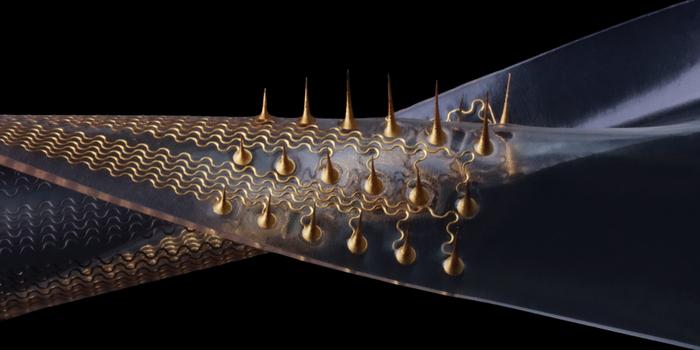A new study led by USC researcher Hangbo Zhao has unveiled a groundbreaking technology that could revolutionize personalized medicine by enabling the development of “soft” and more flexible microneedles. The research, published as the cover story in the prestigious journal Science Advances, presents a novel manufacturing process for stretchable three-dimensional penetrating microelectrode arrays, which are essential for ensuring comfort and high accuracy in long-term health tracking.
Zhao, an assistant professor in the Department of Aerospace and Mechanical Engineering and the Alfred E. Mann Department of Biomedical Engineering at USC, has been at the forefront of research on stretchable sensors for biomedical purposes. His expertise in advanced manufacturing and flexible electronics has led to the development of a more adaptable solution for microneedle electrodes, which are widely used in sensing and stimulation of the brain, as well as diagnosis of biomarkers under the skin.
The Need for Flexible Microneedles
Conventional microneedle electrodes are rigid due to material and fabrication limitations, which can be problematic when dealing with muscle tissues and skin tissues that “deform” or change shape. Zhao’s research has paved the way for advances in microneedles that can sense ever-deeper into tissues and gain more accurate results, making them highly desirable for various biomedical applications.
“The new ‘soft’ microneedle electrodes are highly desirable in the case of muscle tissues and skin tissues that ‘deform’ or change shape,” Zhao explains. “Electrodes need to follow the deformations of the target tissues to ensure intimate contact and minimize tissue damage.”
A Hybrid Fabrication Method
Central to the innovation is the development of a hybrid fabrication method discovered at Zhao’s lab at USC. The low-cost and scalable method combines laser micromachining, microfabrication, and transfer printing to make microneedle electrode arrays with the highest stretchability (60-90%) ever reported. This novel fabrication method enables convenient customization of key device parameters such as electrode geometry, recording sites, and mechanical and electrical properties.
The feasibility of the globally applicable microneedle electrodes was originally demonstrated by recording electrical activities inside the moving muscles of a sea slug. The wider global biomedical applications of the results were immediately clear to Zhao and his team of researchers, as this platform technology can be used for the sensing and control of brain and nerve activities, electrochemical sensing of skin interstitial fluids, diagnosis of neuromuscular disorders, and drug delivery into deep tissues.
As personalized medicine continues to advance, with wearable devices and DIY home testing making it easier than ever to track various health metrics, Zhao’s research represents an important milestone in achieving a seamless interface between the human body and invasive monitoring devices. The development of highly stretchable “soft” microneedles could be the answer for those who feel queasy at the thought of conventional microneedles, while also providing healthcare professionals and biotech companies with more accurate tracking capabilities to catch abnormalities and identify rapid treatment options.
Keyword: soft microneedle electrodes


